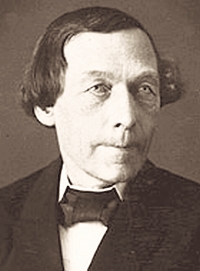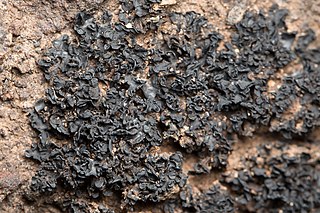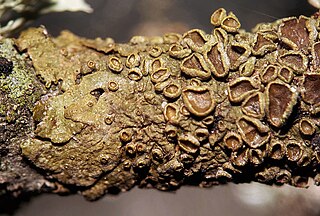
William (Wilhem) Nylander was a Finnish botanist and entomologist. Nylander was born in Oulu, and taught at the University of Helsinki before moving to Paris, where he lived until his death in 1899.

The Lichinaceae are a family of ascomycete fungi. Most species are lichenized with cyanobacteria, and have a distribution largely in temperate regions.
Lithographa is a genus of lichenized fungi in the family Xylographaceae. The genus was circumscribed in 1857 by Finnish botanist William Nylander, with Lithographa petraea assigned as the type species. This species is now known as Lithographa tesserata.
Tremotylium is a genus of lichen-forming fungi in the family Graphidaceae. The genus was circumscribed by Finnish lichenologist William Nylander in 1865, but it was not published validly. He validated the genus and assigned T. angolense as the type species in 1868.
Tylophoron is a genus of lichen-forming fungi in the family Arthoniaceae. The genus was circumscribed in 1862 by Finnish lichenologist William Nylander.
Frigidopyrenia is a fungal genus in the family Xanthopyreniaceae. It is a monotypic genus, containing the single species Frigidopyrenia bryospila, a subarctic crustose lichen. This lichen was originally described by Finnish lichenologist William Nylander in 1864 as Verrucaria bryospila. It was shuffled to several genera in its taxonomic history before Martin Grube circumscribed Frigidopyrenia in 2005 to contain it. As of 2017, no molecular sequence data was available for Frigidopyrenia.

Thelopsis is a genus of lichenized fungi in the family Stictidaceae. It was circumscribed by Finnish lichenologist William Nylander in 1855, with Thelopsis rubella as the type species.

Leptochidium is a genus of lichen-forming fungi in the family Massalongiaceae. It has two species:
Placopsis perrugosa is a saxicolous (rock-dwelling), placodioid lichen in the family Trapeliaceae. It was formally described as a new species in 1867 by Finnish lichenologist William Nylander, originally as a member of the genus Lecanora.

Edvard August Vainio was a Finnish lichenologist. His early works on the lichens of Lapland, his three-volume monograph on the lichen genus Cladonia, and, in particular, his study of the classification and form and structure of lichens in Brazil, made Vainio renowned internationally in the field of lichenology.
Coppinsidea vainioana is a species of crustose lichen in the family Ramalinaceae. It occurs in Europe, where it grows on the bark of pine trees.

Melanohalea subolivacea, commonly known as the brown-eyed camouflage lichen, is a species of foliose lichen in the family Parmeliaceae.

Punctelia subrudecta is a species of lichen in the family Parmeliaceae. It was described as a new species by Finnish lichenologist William Nylander as Parmelia subrudecta. Hildur Krog transferred it to the genus Punctelia in 1982.
Orvo Vitikainen is a Finnish lichenologist. He entered the University of Helsinki in 1961, from where he obtained a Candidate of Philosophy degree in 1966, and a Licentiate of Philosophy in 1971. He later earned a Ph.D. from this institution in 1994, under the supervision of Teuvo Ahti. Between the years 1961 and 1981 he was a junior curator of cryptogams at the University of Helsinki Botanical Garden, and then from 1983 to 2004 he was the head of the lichen herbarium. Here he managed the internationally valuable collections of the early lichenologists Erik Acharius and William Nylander. He has collected thousands of specimens for the herbarium from various locations in Finland, but also internationally, including Sweden, Norway, Denmark, Russian Karelia, Scotland, Austria, Italy, Hungary, Croatia, Montenegro, Tanzania, Kenya, British Columbia, and Brazil. In 1992–1994, he was a scientist of the Finnish Academy in the Ahti research group.

Xylographaceae is a family of lichen-forming fungi in the order Baeomycetales. It contains four genera and 25 species.

Flavoparmelia soredians is a widely distributed species of foliose lichen in the large family Parmeliaceae.

Gowardia nigricans, commonly known as the gray hair lichen or gray witch's hair, is a species of fruticose lichen in the family Parmeliaceae.

Pyrenula ochraceoflava is a species of corticolous, crustose lichen in the family Pyrenulaceae. It is a common lowland and coastal species with a pantropical distribution. Its distribution in the Pacific Ocean includes the Caroline Islands, Galápagos Islands, New Caledonia, Tuamotu, and Western Samoa. The lichen was first formally described by Finnish lichenologist William Nylander in 1858 as a species of Verrucaria. Richard Harris transferred it to the genus Pyrenula in 1989. The variety pacifica, found on the Cook Islands was proposed by Patrick McCarthy in 2000. It is distinguished from the nominate variety by its pigmented thallus and perithecia, ascospore size and shape, and the presence of a single transverse septum in its ascospores.
Pyrenidium is a genus of lichenicolous (lichen-dwelling) fungi. It is the only genus in the family Pyrenidiaceae. It has 13 species.
Diromma is a monotypic fungal genus in the family Roccellaceae. It contains the single species Diromma dirinellum, a rare crustose lichen that grows as a parasite on the lichen Dirina ceratoniae. It has a distribution restricted to the Mediterranean Basin.










